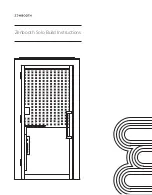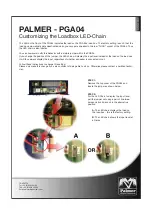
SDR24/96 Quick-Start Guide
P R O J E C T : F e e l t h e L o v e
A V A I L : 0 2 : 2 7 : 2 6 o n E X T
44.1k
VARI
48k
24 BIT
16 BIT
TC
ERROR
MINUTES
HOURS
SECONDS
FRAMES
EXT
CLOCK
SELECT
SELECT
SELECT
SELECT
POWER
24 TRACK/24 BIT DIGITAL AUDIO RECORDER
ALL
INPUT
AUTO
INPUT
PUNCH
REHRSE
LOOP
LOCATE
STORE
DELETE
LAST
SETUP
EDIT
T-CODE
CHASE
AUTO
TAKE
TRACK
PROJECT
24
23
22
21
20
19
18
17
16
15
14
13
12
11
10
9
8
7
6
5
4
3
2
1
HIGH RESOLUTION
NON-LINEAR RECORDER
X2
96
SDR
REWIND
FAST FWD
PLAY
STOP
RECORD
Getting Started
Project
• Start a new project (
PROJECT:New
). Either accept
the default name (
Project#1
) by selecting
New
, or press
Page Right
to enter a new name. When finished,
press Page Left
and select
New
.
I/O
•
Choose either the
analog inputs
or
digital inputs
using
the
INPUT TYPE SELECT
menu (
SETUP:I/O:Page
Right Twice
:INPUT TYPE SELECT
), or customize
a combination of both.
See “Hookups” on page 12 of the Operation Manual for
examples of both analog and digital connections.
• By default, track numbers are assigned to their
corresponding inputs and outputs. You can customize
the mapping of the inputs (
SETUP:I/O:TRACK INPUT
SELECT
) and outputs (
SETUP:I/O:Page Right
:
TRACK OUTPUT SELECT
) to different tracks.
Sync:
• Choose the
sample clock source
(
SETUP:Sync:SClk
).
If the SDR24/96 is providing the master clock, select
Internal. If the SDR is a slave and syncing to an
external clock through the Word Clock input, select
Word Clock. Select ADAT A, B, or C if syncing to a self-
clocking ADAT™ optical input.
• Choose the
sample rate
(
SETUP:Sync:SRate
). When
recording with the analog inputs, choose any sample
rate appropriate for your project.
You must use the same
sample rate throughout a project.
When recording with
the digital inputs, the sample rate must be the same as
the digital source.
• Choose your preferred
sample size
(
SETUP:Sync:Page
Right
:SSize
), either 16-bit or 24-bit.
• Choose the
time code source
(
SETUP:Sync:TcSrc
) if
the SDR is chasing to time code (
T-CODE CHASE
). Use
Jam Continuous when all devices are synced to the
same master clock. Use Chase when the you are using
the SDR24/96’s internal sample clock (no external clock
connected) and you want to sync to external time code.
Front Panel Description
Channel Level Indicators:
Indicate the signal level
at the inputs or outputs, depending on the monitoring
mode selected. OL on the meter corresponds to +22 dBu
at the analog input, and 0 dBFS at the digital input.
Record Ready Buttons:
Used to arm tracks for
recording, or to select tracks for editing. The red LED at
the bottom of the meter blinks while in Record Standby,
and lights steadily while actually recording.
POWER Switch:
Turns the SDR24/96 on and off.
Drive Bay:
For removable drives like the Mackie
Media M•90 and the Project ORB™ cartridge.
DELETE LAST:
Deletes the last record pass (must
be the last action in the History List). You cannot undo
Delete Last.
TRACK:
Accesses track options including Mute,
Virtual Tracks, and Track Name.
PROJECT:
Accesses project options including New,
Open, Save, Save As, Delete, Copy, Rename, and Purge.
EDIT:
Accesses common editing functions such as
Delete, Cut, Copy, Paste, Place, Undo, and Redo.
SETUP:
Accesses the following options:
•
Record Options
♦
Record Safe
♦
Locator Mode
♦
Preroll before Locator
♦
Auto Take Mode
♦
Preroll
♦
One Button Record
♦
Postroll
•
I/O Options
♦
Track Input Select
♦
Input Type Select
♦
Track Output Select
•
Sync Options
♦
Sample Clock
♦
Sample Size
♦
Sample Rate
♦
LTC Out
♦
Time Code Source
♦
MTC Out
♦
Frame Rate
♦
VariSpeed
•
Transport Options
♦
Locate 1-4
♦
Relative Offset
♦
Current Locator Position
♦
Relative Mode
♦
Transport Offset
♦
Auto Play
•
Disk Options
♦
Mount Drive
♦
Defragment Drive
♦
Format Drive
•
System Options
♦
USB Mass Storage Mode
♦
System Load
♦
SDR Footswitch
♦
Date
♦
Remote Footswitch
♦
Time
♦
About




















